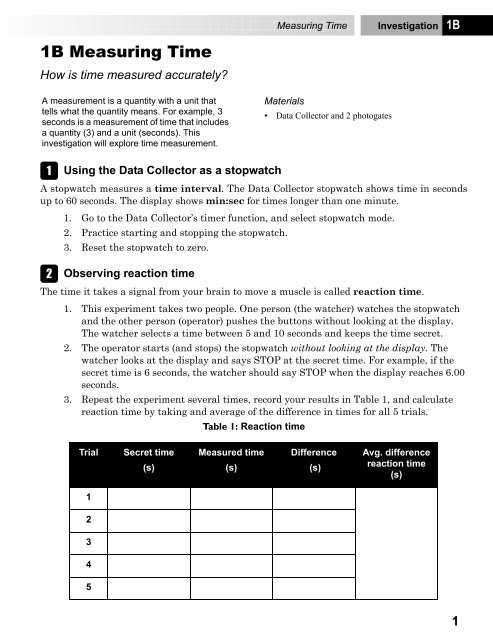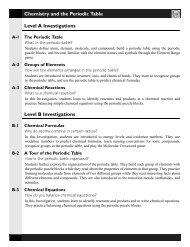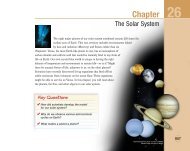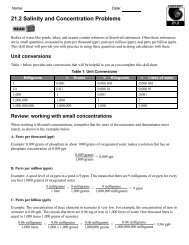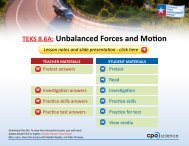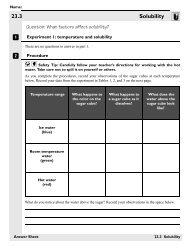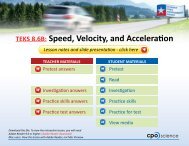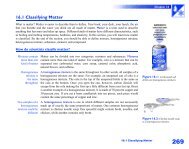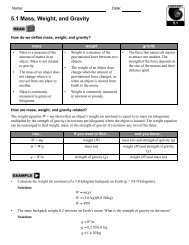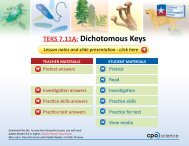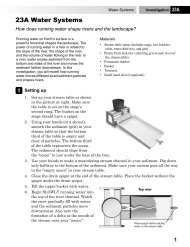Create successful ePaper yourself
Turn your PDF publications into a flip-book with our unique Google optimized e-Paper software.
<strong>Measuring</strong> <strong>Time</strong> Investigation <strong>1B</strong><br />
<strong>1B</strong> <strong>Measuring</strong> <strong>Time</strong><br />
How is time measured accurately?<br />
A measurement is a quantity with a unit that<br />
tells what the quantity means. For example, 3<br />
seconds is a measurement of time that includes<br />
a quantity (3) and a unit (seconds). This<br />
investigation will explore time measurement.<br />
Materials<br />
• Data Collector and 2 photogates<br />
A<br />
Using the Data Collector as a stopwatch<br />
A stopwatch measures a time interval. The Data Collector stopwatch shows time in seconds<br />
up to 60 seconds. The display shows min:sec for times longer than one minute.<br />
B<br />
1. Go to the Data Collector’s timer function, and select stopwatch mode.<br />
2. Practice starting and stopping the stopwatch.<br />
3. Reset the stopwatch to zero.<br />
Observing reaction time<br />
The time it takes a signal from your brain to move a muscle is called reaction time.<br />
1. This experiment takes two people. One person (the watcher) watches the stopwatch<br />
and the other person (operator) pushes the buttons without looking at the display.<br />
The watcher selects a time between 5 and 10 seconds and keeps the time secret.<br />
2. The operator starts (and stops) the stopwatch without looking at the display. The<br />
watcher looks at the display and says STOP at the secret time. For example, if the<br />
secret time is 6 seconds, the watcher should say STOP when the display reaches 6.00<br />
seconds.<br />
3. Repeat the experiment several times, record your results in Table 1, and calculate<br />
reaction time by taking and average of the difference in times for all 5 trials.<br />
Table 1: Reaction time<br />
Trial<br />
Secret time<br />
(s)<br />
Measured time<br />
(s)<br />
Difference<br />
(s)<br />
Avg. difference<br />
reaction time<br />
(s)<br />
1<br />
2<br />
3<br />
4<br />
5<br />
1
Investigation<br />
<strong>1B</strong><br />
<strong>Measuring</strong> <strong>Time</strong><br />
C<br />
Mixed units for time<br />
In physical science, you are usually going to measure time in seconds. However, time is often<br />
given in mixed units, which may include hours, minutes, and seconds. Consider the following<br />
three time intervals.<br />
1. 16,000 seconds<br />
2. 250 minutes<br />
3. 4 hours, 23 minutes and 15 seconds (4:23:15)<br />
a. Which one is in mixed units?<br />
b. Can you tell which time is longest or shortest?<br />
c. 1 minute = 60 seconds; how many seconds is 250 minutes?<br />
d. 1 hour = 60 minutes; how many minutes are in 4 hours?<br />
e. Use your answer from question d. to figure out how many seconds are in 4:23:15.<br />
f. Arrange the three measurements from smallest to largest.<br />
2
D<br />
Using the photogates<br />
A photogate allows us to use an infrared light beam to start and stop<br />
the Data Collector. When the timer function is in interval mode, it<br />
uses photogates to control the clock.<br />
1. Connect a single photogate to the “A” input with a cord.<br />
2. Select interval mode in the timer function of the Data<br />
Collector.<br />
3. Try blocking the infrared beam with your finger and observe<br />
what happens on the timer display.<br />
<strong>Measuring</strong> <strong>Time</strong> Investigation <strong>1B</strong><br />
Try your own experiments until you can answer the<br />
following questions. Be very specific in your answer.<br />
Someone who has never used the Data Collector before<br />
should be able to read your answer and know what to do<br />
with the infrared beam to make the clock start and stop.<br />
a. How do you start the clock?<br />
b. How do you stop the clock?<br />
c. What time interval has the clock measured?<br />
E<br />
Using two photogates<br />
1. Connect a second photogate to the Data Collector.<br />
2. Make sure the light on each photogate is green and press<br />
the reset button. Pressing reset clears the clocks and also<br />
tells the timer to look at its inputs to see which photogates<br />
are connected.<br />
3. Do your own experiments and fill in the rest of Table 2.<br />
3
Investigation<br />
<strong>1B</strong><br />
<strong>Measuring</strong> <strong>Time</strong><br />
Table 2: <strong>Time</strong>r and photogate rules<br />
t A<br />
How do you start the t A clock?<br />
How do you stop the t A clock?<br />
t B<br />
How do you start the t B clock?<br />
How do you stop the t B clock?<br />
t AB<br />
How do you start the t AB clock?<br />
How do you stop the t AB clock?<br />
4


